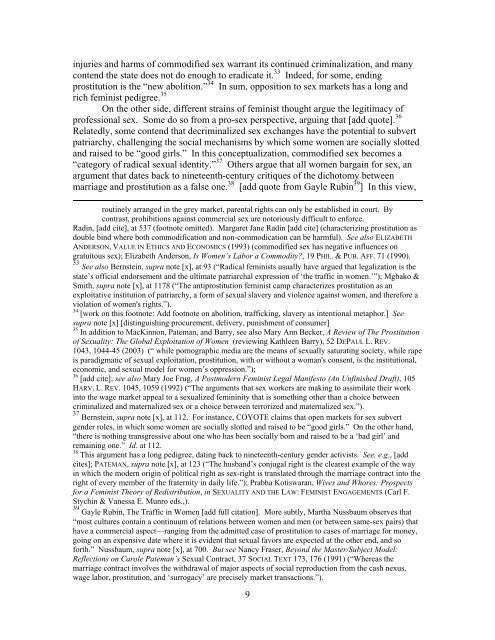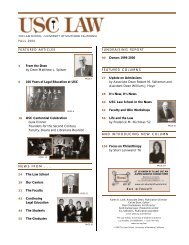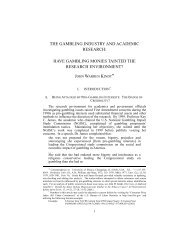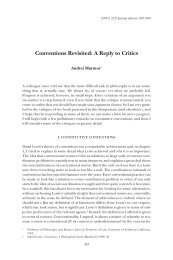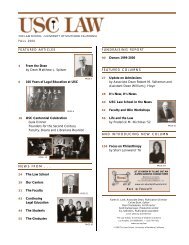1 Regulating Sex Work Adrienne D. Davis VERY ROUGH DRAFT ...
1 Regulating Sex Work Adrienne D. Davis VERY ROUGH DRAFT ...
1 Regulating Sex Work Adrienne D. Davis VERY ROUGH DRAFT ...
Create successful ePaper yourself
Turn your PDF publications into a flip-book with our unique Google optimized e-Paper software.
injuries and harms of commodified sex warrant its continued criminalization, and many<br />
contend the state does not do enough to eradicate it. 33 Indeed, for some, ending<br />
prostitution is the “new abolition.” 34 In sum, opposition to sex markets has a long and<br />
rich feminist pedigree. 35<br />
On the other side, different strains of feminist thought argue the legitimacy of<br />
professional sex. Some do so from a pro-sex perspective, arguing that [add quote]. 36<br />
Relatedly, some contend that decriminalized sex exchanges have the potential to subvert<br />
patriarchy, challenging the social mechanisms by which some women are socially slotted<br />
and raised to be “good girls.” In this conceptualization, commodified sex becomes a<br />
“category of radical sexual identity.” 37 Others argue that all women bargain for sex, an<br />
argument that dates back to nineteenth-century critiques of the dichotomy between<br />
marriage and prostitution as a false one. 38 [add quote from Gayle Rubin 39 ] In this view,<br />
routinely arranged in the grey market, parental rights can only be established in court. By<br />
contrast, prohibitions against commercial sex are notoriously difficult to enforce.<br />
Radin, [add cite], at 537 (footnote omitted). Margaret Jane Radin [add cite] (characterizing prostitution as<br />
double bind where both commodification and non-commodication can be harmful). See also ELIZABETH<br />
ANDERSON, VALUE IN ETHICS AND ECONOMICS (1993) (commodified sex has negative influences on<br />
gratuitous sex); Elizabeth Anderson, Is Women’s Labor a Commodity?, 19 PHIL. & PUB. AFF. 71 (1990).<br />
33 See also Bernstein, supra note [x], at 93 (“Radical feminists usually have argued that legalization is the<br />
state’s official endorsement and the ultimate patriarchal expression of ‘the traffic in women.’”); Mgbako &<br />
Smith, supra note [x], at 1178 (“The antiprostitution feminist camp characterizes prostitution as an<br />
exploitative institution of patriarchy, a form of sexual slavery and violence against women, and therefore a<br />
violation of women's rights.”).<br />
34 [work on this footnote: Add footnote on abolition, trafficking, slavery as intentional metaphor.] See<br />
supra note [x] [distinguishing procurement, delivery, punishment of consumer]<br />
35 In addition to MacKinnon, Pateman, and Barry, see also Mary Ann Becker, A Review of The Prostitution<br />
of <strong>Sex</strong>uality: The Global Exploitation of Women (reviewing Kathleen Barry), 52 DEPAUL L. REV.<br />
1043, 1044-45 (2003) (“ while pornographic media are the means of sexually saturating society, while rape<br />
is paradigmatic of sexual exploitation, prostitution, with or without a woman's consent, is the institutional,<br />
economic, and sexual model for women’s oppression.”);<br />
36 [add cite]; see also Mary Joe Frug, A Postmodern Feminist Legal Manifesto (An Unfinished Draft), 105<br />
HARV. L. REV. 1045, 1059 (1992) (“The arguments that sex workers are making to assimilate their work<br />
into the wage market appeal to a sexualized femininity that is something other than a choice between<br />
criminalized and maternalized sex or a choice between terrorized and maternalized sex.”).<br />
37 Bernstein, supra note [x], at 112. For instance, COYOTE claims that open markets for sex subvert<br />
gender roles, in which some women are socially slotted and raised to be “good girls.” On the other hand,<br />
“there is nothing transgressive about one who has been socially born and raised to be a ‘bad girl’ and<br />
remaining one.” Id. at 112.<br />
38 This argument has a long pedigree, dating back to nineteenth-century gender activists. See, e.g., [add<br />
cites]; PATEMAN, supra note [x], at 123 (“The husband’s conjugal right is the clearest example of the way<br />
in which the modern origin of political right as sex-right is translated through the marriage contract into the<br />
right of every member of the fraternity in daily life.”); Prabha Kotiswaran, Wives and Whores: Prospects<br />
for a Feminist Theory of Redistribution, in SEXUALITY AND THE LAW: FEMINIST ENGAGEMENTS (Carl F.<br />
Stychin & Vanessa E. Munro eds.,).<br />
39 Gayle Rubin, The Traffic in Women [add full citation]. More subtly, Martha Nussbaum observes that<br />
“most cultures contain a continuum of relations between women and men (or between same-sex pairs) that<br />
have a commercial aspect—ranging from the admitted case of prostitution to cases of marriage for money,<br />
going on an expensive date where it is evident that sexual favors are expected at the other end, and so<br />
forth.” Nussbaum, supra note [x], at 700. But see Nancy Fraser, Beyond the Master/Subject Model:<br />
Reflections on Carole Pateman’s <strong>Sex</strong>ual Contract, 37 SOCIAL TEXT 173, 176 (1991) (“Whereas the<br />
marriage contract involves the withdrawal of major aspects of social reproduction from the cash nexus,<br />
wage labor, prostitution, and ‘surrogacy’ are precisely market transactions.”).<br />
9


